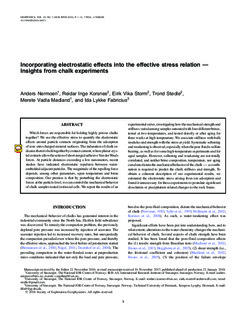| dc.contributor.author | Nermoen, Anders | |
| dc.contributor.author | Korsnes, Reidar Inge | |
| dc.contributor.author | Storm, Eirik V. | |
| dc.contributor.author | Stødle, Trond | |
| dc.contributor.author | Madland, Merete Vadla | |
| dc.contributor.author | Fabricius, Ida Lykke | |
| dc.date.accessioned | 2018-02-21T09:29:29Z | |
| dc.date.available | 2018-02-21T09:29:29Z | |
| dc.date.created | 2018-02-20T10:29:51Z | |
| dc.date.issued | 2018-01 | |
| dc.identifier.citation | Nermoen, A. et al. (2018) Incorporating electrostatic effects into the effective stress relation — Insights from chalk experiments. Geophysics. 2018, 83 (3). | nb_NO |
| dc.identifier.issn | 0016-8033 | |
| dc.identifier.uri | http://hdl.handle.net/11250/2486126 | |
| dc.description | This is an author accepted manuscript of an article from the journal Geophysics, published by the Society of Exploration Geophysicists (SEG). Reuse is subject to SEG terms of use and conditions. | nb_NO |
| dc.description.abstract | Which forces are responsible for holding highly porous chalks together? We use the effective stress to quantify the electrostatic effects around particle contacts originating from the adsorption of ions onto charged mineral surfaces. The induration of chalk indicates that it is held together by contact cement,where planar crystal contacts allowthe action of short-ranged adhesive Van der Waals forces. At particle distances exceeding a few nanometers, recent studies have indicated electrostatic repulsion between water embedded adjacent particles. The magnitude of the repelling force depends, among other parameters, upon temperature and brine composition. Our premise is that by perturbing the electrostatic forces at the particle level, we can control themechanical behavior of chalk samples tested in triaxial cells.We report the results of an experimental series, investigating howthemechanical strength and stiffness varied among samples saturated with four different brines, tested at two temperatures, and tested directly or after aging for three weeks at high temperature. We associate stiffness with bulk modulus and strengthwith the stress at yield. Systematic softening and weakening is observed, especially when the pore fluid is sulfate bearing, as well as for some high-temperature experiments and for aged samples. However, softening and weakening are not totally correlated, and neither brine composition, temperature, nor aging can alone dictate the mechanical behavior of the chalk — a combination is required to predict the chalk stiffness and strength. To obtain a coherent description of our experimental results, we estimated the electrostatic stress arising from ion adsorption and found it unnecessary for these experiments to postulate significant dissolution or precipitation-related changes to the rock frame. | nb_NO |
| dc.language.iso | eng | nb_NO |
| dc.publisher | Society of Exploration Geophysicists | nb_NO |
| dc.subject | geofysikk | nb_NO |
| dc.title | Incorporating electrostatic effects into the effective stress relation — Insights from chalk experiments | nb_NO |
| dc.type | Journal article | nb_NO |
| dc.type | Peer reviewed | nb_NO |
| dc.description.version | acceptedVersion | nb_NO |
| dc.rights.holder | © 2018 Society of Exploration Geophysicists. All rights reserved. | nb_NO |
| dc.subject.nsi | VDP::Matematikk og Naturvitenskap: 400::Geofag: 450::Petroleumsgeologi og -geofysikk: 464 | nb_NO |
| dc.source.pagenumber | 13 | nb_NO |
| dc.source.volume | 83 | nb_NO |
| dc.source.journal | Geophysics | nb_NO |
| dc.source.issue | 3 | nb_NO |
| dc.identifier.doi | 10.1190/GEO2016-0607.1 | |
| dc.identifier.cristin | 1566923 | |
| cristin.unitcode | 217,8,6,0 | |
| cristin.unitcode | 217,8,6,50 | |
| cristin.unitname | Institutt for petroleumsteknologi | |
| cristin.unitname | Laboratorium IPT | |
| cristin.ispublished | true | |
| cristin.fulltext | postprint | |
| cristin.qualitycode | 2 | |
